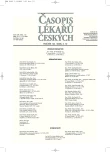Apoptosis of Urothelial Carcinoma Cells
Apoptóza u buněk uroteliálního karcinomu
Východisko.
Programovaná smrt buňky, apoptóza, je fyziologickým, geneticky řízeným dějem. Je osudem většiny buněk vzniklých v průběhu somatického vývoje a dalšího života u většiny organizmů. V publikovaném souboru uvádíme data získaná z vyšetření buněk uroteliálního karcinomu, porovnaná s histochemickými výsledky.
Metody a výsledky.
V letech 1999–2002 jsme vyšetřili 36 nativních vzorků moče odebraných od pacientů s verifikovaným uroteliálním karcinomem. U 9 pacientů se jednalo o nádorový grading II.stupně, u 27 pacientů šlo o nádorový grading III. stupně. Vzorky jsme vyšetřili průtokovou cytometrií a získaná data jsme porovnali s nádorovým gradingem. V souboru jsme prokázali nulovou apoptotickou aktivitu nádorových buněk u 32 pacientů (88,9 %) ze 36 vyšetřených. U 4 pacientů, u kterých byla apoptóza zachovaná se jednalo o nádorový grading III.stupně.
Závěry.
V souboru jsme zaznamenali výrazné chybění apoptózy u populace nádorových buněk. Předpoklad zachování apoptózy u nižšího stupně gradingu nádorů proti vyššímu stupni se nepotvrdil zjištěním zachované apoptózy u 4 nádorů s gradingem III. Při porovnání gradingu nádorů byla apoptóza oslabena nejvýrazněji u skupiny nádorových buněk s nejvyšším histopatologickým gradingem. Získali jsme hodnoty vyjadřující přímo úměrný vztah mezi dějem apoptózy a histopatologickým gradingem.
Klíčová slova:
apoptóza, uroteliální karcinom, průtoková cytometrie.
Authors:
M. Louda 1; D. Vokurková 2; E. Šimáková 3
Authors‘ workplace:
Urologická klinika FN, Hradec Králové
1; Ústav klinické imunologie a alergologie FN, Hradec Králové
2; Fingerlandův ústav patologie FN, Hradec Králové
3
Published in:
Čas. Lék. čes. 2005; 144: 817-820
Category:
Original Article
Overview
Background.
Programmed cells death, apoptosis, is a physiological, genetically controlled mechanism. It represents the fate of the majority of cells formed during the somatic development and during the next life of most of the creatures. In the article, data from the study of urothelial carcinoma cells are presented and compared with histochemical analysis.
Methods and Results.
During 1999 to 2002 native urine samples of 36 of patients with the verified urothelial carcinoma were studied. Nine patients had tumors of the grade II, 27 patients had tumors of grade III. Urine samples were analysed by flow cytometry and the data obtained were compared with tumor gradients. In our cohort the zero apoptotic activity was found in 32 patients (88.9 %). In four patients with preserved apoptosis the tumors were of the grade III.
Conclusions.
Lack of apoptosis of the tumor cells was the dominant sign in our sample. The premise of existing apoptosis in tumors of the lower grade contrary to the higher one was not confirmed when apoptosis was found in four tumors of the grade III. When the tumor grading was compared, apoptosis was less active in the group of tumors with the highest histopathologic grading. Values expressing the direct relation between apoptosis and the histopathologic grading were obtained.
Key words:
apoptosis, urothelial carcinoma, flow cytometry.
Labels
Addictology Allergology and clinical immunology Angiology Audiology Clinical biochemistry Dermatology & STDs Paediatric gastroenterology Paediatric surgery Paediatric cardiology Paediatric neurology Paediatric ENT Paediatric psychiatry Paediatric rheumatology Diabetology Pharmacy Vascular surgery Pain management Dental HygienistArticle was published in
Journal of Czech Physicians

- Metamizole at a Glance and in Practice – Effective Non-Opioid Analgesic for All Ages
- What Effect Can Be Expected from Limosilactobacillus reuteri in Mucositis and Peri-Implantitis?
- Advances in the Treatment of Myasthenia Gravis on the Horizon
- The Importance of Hydration in Wound Healing
Most read in this issue
- Renal Angiomyolipoma, Histology, Diagnostics and Therapy
- Mosaicplasty in the Treatment of Knee Injuries
- Cognitive Dysfunction and Its Therapy
- Combined Immunosuppressive Therapy in Patients with Pemphigus Vulgaris and Its Side Effects
